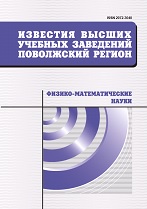|
|
University proceedings. Volga region. Physical and mathematical sciences, 2015, Issue 1, Pages 110–119
(Mi ivpnz309)
|
 |
|
 |
Physics
Diamagnetism of dielectronic impurity centers in semiconductor quantum dots
V. D. Krevchik, A. V. Razumov, P. S. Budyansky
Penza State University, Penza
Abstract:
Background. A large number of impurity centers in semiconductors may possess not one, but two electrons in the bound state. The magnetic moment of such impurity centers, causing paramagnetism, equals to zero. In this connection the dielectronic impurity centers may possess only diamagnetic properties, researching of which allows to obtain valuable information on the pattern of semiconductor's structural changes depending on changes in the content of the dielectronic impurity therein. The interest to invrstigation of magnetic properties of quantum dots with dielectronic impurity centers is caused, first of all, by a new physical situation, associated with quantum size effect. From the practical point of view, such systems may be used in development of qubits and lazer structures on impurity transitions. The aim of the work is to theoretically investigate the features of diamagnetic susceptibility of a neutral dielectronic impurity center in a quantum dot, associated with size quantizetion. The authors compare the obtained results with a case of diamagnetic susceptibility of the one-electron $D^-$-center in a quantum dot, as well as with a case of a neutral impurity center in a bulk semiconductor. Materials and methods. Theoretical claculations of diamagnetic susceptibility were carried out for a case of the InSb quantum dot. On the basis of the two-electron model of the impurity center, the potential of which appears to be a zero radius potential, the authors conducted a variation calculation of the energy of the impurity's main condition in a spherical quantum dot. The second potential of ionization, determining the energy of the main condition of such an impurity center in a quantum dot, was considered as an empirical parameter. Diamagnetic susceptibility of the two-electron impurity center was calculated by the Langevin-Pauli formula. Results. It is shown that the diamagnetic susceptibility of a neutral impurity center in a quantum dot is lower the corresponding value in a bulk semiconductor. Herewith, with the decrease of the second potential of ionization their relation slowly increases, and with the increase of the quantum dot radius it tends to unity. It is revealed that the value of diamagnetic susceptibility of the two-electron impurity center in a quantum dot is vereal times greater than the value of diamagnetic susceptibility of the one-electron $D^-$-center, and with the increase of the quantum dot radius this difference becomes stronger. It is found that the diamagnetic susceptibility quite rapidly fades away at transition to deeper impurity centers. Conclusions. The presence of the quantum size effect leads to the decrease of diamagnetic susceptibility of both one-electron and two-electron impurity centers at the transition “bulk semiconductor-quantum dot”. In quantum dots, the typical size of which exceeds the exciton's Bohr radius, the contribution of two-electron impurity centers into diamagnetic susceptibility may be significant.
Keywords:
two-electron impurity centers, ionization potential, diamagnetic susceptibility, quantum dot.
Citation:
V. D. Krevchik, A. V. Razumov, P. S. Budyansky, “Diamagnetism of dielectronic impurity centers in semiconductor quantum dots”, University proceedings. Volga region. Physical and mathematical sciences, 2015, no. 1, 110–119
Linking options:
https://www.mathnet.ru/eng/ivpnz309 https://www.mathnet.ru/eng/ivpnz/y2015/i1/p110
|

| Statistics & downloads: |
| Abstract page: | 44 | | Full-text PDF : | 15 | | References: | 12 |
|




 Contact us:
Contact us: Terms of Use
Terms of Use
 Registration to the website
Registration to the website Logotypes
Logotypes








 Citation in format
Citation in format 